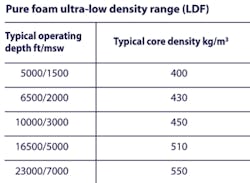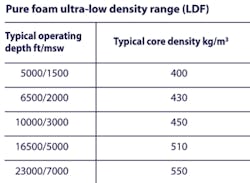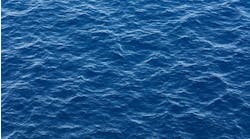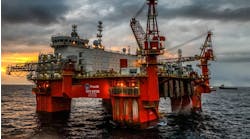Consilium Marine & Safety has developed an oil spill radar for use with a ship’s existing navigational radar equipment. It was successfully tested during Norway’s annual Oil at Sea exercise in the North Sea this summer.
The first system has been installed on the Finnish coastguard’s ice-breakerKontio, which is also fitted out as an oil recovery vessel. The Kontio is part of the European Maritime Safety Agency’s network of standby vessels for tackling oil spills in the Baltic Sea.
An oil slick detected by Consilium’s oil spill radar shows up as a dark patch on the radar screen.
Norway’s Oil at Sea exercise, conducted by the Norwegian Clean Seas Association for Operating Companies (NOFO), was staged in June at the location of the now depleted Frigg field, where around 100 cu m of crude was released into the sea. A task force of some 10 boats, helicopters and aircraft monitored and cleaned up the spill under the coordination and supervision of the Norwegian Coastal Administration.
The Consilium Selesmar Selux ST 340 radar display and a 12 kW, 9-ft (2.7-m) antenna radar sensor were temporarily installed on the Norwegian coastguard vesselKV Bergen.
The Selux ST 340 radar display was equipped with an add-on software package containing an advanced hardware video processing function which permits the detection and tracking of oil slicks. The film of oil on the water reduces its reflectivity, so that oily areas show up as dark patches on the radar screen.
The trials were performed during the day and at night, and in sea states varying from 2 to 4 (wave heights of up to 2.5 m, or 8.2 ft). Oil slicks were detected under all these conditions.
An integral part of the company’s delivery is a master/slave inter-switch board that permits easy interfacing of the oil spill radar display to all the radar sensors of the navigational radar system.
While there are other oil spill radars, Consilium’s is claimed to be the first to run on standard navigational radar equipment, according to Massimo Carmagnini, Consilium Marine’s product manager radar.
The advanced video processing allows the system to operate under all conditions of visibility, including the hours of darkness. As Carmagnini points out, this means it can be used to detect illegal discharge of oil at night. And given the offshore industry’s move toward operating in Arctic regions, with restricted daylight during winter, it could also help minimize damage in the event of accidental oil spills.
For more information contact Massimo Carmagnini, Consilium Marine & Safety. Tel +39 335 757 9316, fax +39 0571 67 07 98,[email protected], www.consilium.se
Offshore Articles Archives
View Oil and Gas Articles on PennEnergy.com




